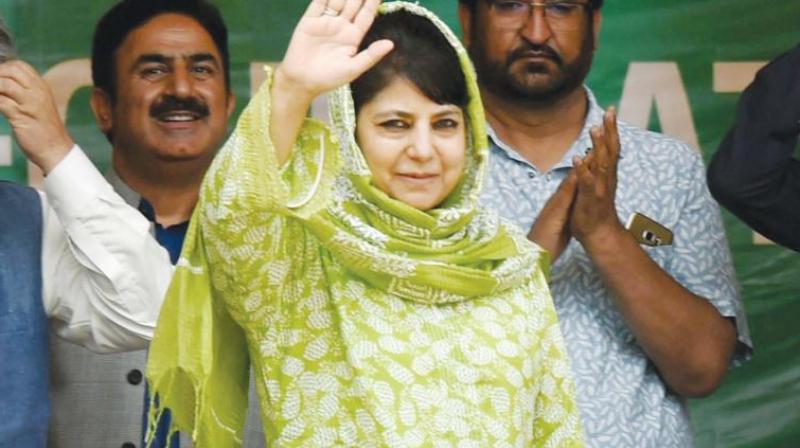The PDP-BJP coalition was a flawed alliance

When Mufti Mohammed Sayeed justified the unscrupulous coalition of his Valley-centred PDP with the Jammu-based BJP in 2014, as the meeting of the North Pole and the South Pole, he did not realise that this puerile metaphor would provide the best explanation for its break up. The two poles can never meet. The BJP quit the coalition on June 19, 2018. Each found its base, regional and religious, shrinking. Next year, if not sooner, the BJP will go to the polls. Prime Minister Narendra Modi’s popularity is on the decline. His first priority is to consolidate his Hindu vote bank. In 2014, the BJP sensed a rare, fleeting opportunity to acquire a presence in the Valley. Parleys were begun with Mufti Mohammed Sayeed before the 2014 Assembly elections. They yielded a fractured verdict for a House of 87-28 seats for the PDP; 25 for the BJP; 15 for the National Conference run by father and son Farooq and Omar Abdullah; and 12 for the Congress. The BJP’s seats came from Jammu alone. It did not win a single seat in the Valley or in Ladakh. The PDP won three seats from Jammu and 25 in the Valley; the NC won 12 seats in the Valley and three in Jammu; the Congress won five from Jammu, four from the Valley and three from Ladakh. The BJP sought to form a government in J&K by itself, by winning all the seats in Jammu and the Buddhist-dominated Ladakh, and stealing the rest from others in the Valley. Sensing this, the PDP made an all-out effort to defeat the BJP. While Kashmir’s Muslims ignored the Hurriyat’s appeal to boycott the polls, they felt cheated when the PDP forged a coalition with the BJP.
The coalition’s Agenda of Alliance was deceptive, with the RSS’ writ dominating its terms. The PDP had demanded “self-rule”, greater than the NC’s demand for “autonomy”; plus an external dimension. There must be an accord with Pakistan on mechanisms to link the two halves of Kashmir and, eventually, for a settlement of the Kashmir dispute. All this was omitted in the agenda. It recorded the two sides’ disagreement on Article 370, the Indian Constitution’s guarantee of “autonomy”, which has been completely hollowed out. Modi made no secret of his agenda. When he went to Srinagar for the Mufti’s swearing in as chief minister in March 2015, he snubbed the chief minister when he pleaded for efforts at a settlement with Pakistan. The coalition stumbled along even after Mehbooba became chief minister after her father’s death. The power upsurge after Burhan Wani’s killing in 2018 found her wanting. She stooped so low as even to justify the use of pellet guns against her own people. Polls were due in 2020, but as the clock ticked away, she found her unpopularity increase. The BJP also found that its base in Jammu was shrinking. The tipping point was the rape-murder of an eight-year-old Muslim girl in Jammu, whose body was found on January 17, 2018. Two of the BJP’s ministers in Jammu supported the perpetrators. The worm began to turn. Mehbooba secured their resignation on April 15. The BJP replaced them with more rabid Jammuites.
Mehbooba pressed the PM and home minister to initiate a process of conciliation within J&K, and with Pakistan. She knew that Kashmiris yearn for a settlement of the dispute. This was contrary to Modi’s policy. And in J&K, the Indian Army launched Operation All Out in 2017, with the BJP’s strategic adviser stating that the government would “eliminate all militants”. In retrospect, it is clear that that what followed her entreaties was a charade to serve as a prelude to a crackdown. The rape case had exposed the depths of the divide between J&K. What shocked everyone was the spurt in local recruitment in the ranks of fighters. It was a response to the growing vandalism of the security forces. In mid-May came the “unilateral” ceasefire during Ramzan. The random cordon-and-search operations were stopped, but not those based on specific intelligence.
Nothing exposed New Delhi’s insincerity more than home minister Rajnath Singh’s appeal for talks in Srinagar on May 26, 2018. “If Hurriyat is ready to talk, we have no problem, we are ready to talk.” Syed Ali Shah Geelani’s response on May 29 was positive. If the government “gives clarity on what it wants to talk about and speaks in one language (they) are ready to join the process”. India has nothing to offer to them. On June 17, the ceasefire was ended. On June 19, the BJP ended the coalition, paving the way for Governor’s Rule. The BJP has given contradictory reasons for the step. The real reasons are the polls in 2019 and the Centre’s desire to get the PDP out of the way to crush the militancy in J&K. It will not work. The situation will get worse.
By arrangement with Dawn

